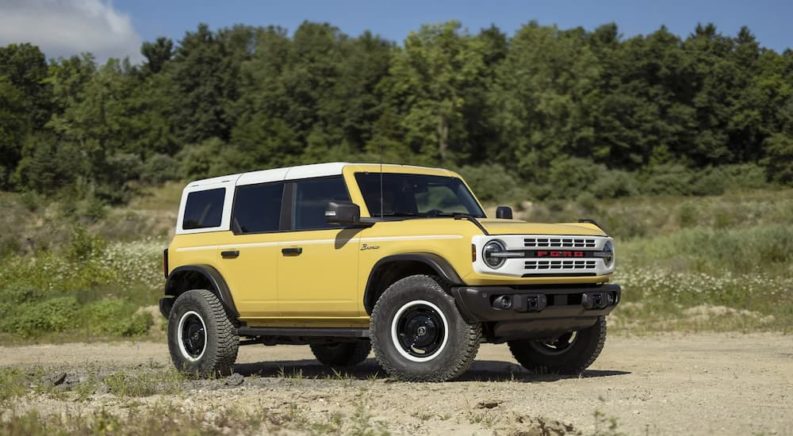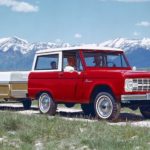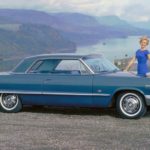Few vehicles can match the legendary status of the Ford Bronco. The iconic SUV is one of the most recognizable vehicles to ever roll off an American assembly line, with the original version sporting a boxy, two-tone design that made the Bronco an instant classic upon its debut in 1965. Originally hitting the streets as a compact, two-door SUV, the Bronco morphed is perhaps best remembered for its full-size guise that spanned from 1977 until 1996, when Ford discontinued the popular model.
The Blue Oval revived the Bronco in 2021, caching in on the SUV’s nostalgia value and introducing a whole new generation of drivers to this unique offering. Now entering its third year with the 2023 Ford Bronco model, the consumer response has been impressive, with the new mid-size version outselling Toyota’s 4Runner and quickly closing the gap with the long-time sector-leading Jeep Wrangler. The numbers don’t tell the whole story, though, because while the Bronco might not yet be the industry’s best-selling mid-size SUV, it’s certainly got the advantage when it comes to history.
As drivers start to hit the streets in the new 2023 Ford Bronco, we thought it would be the perfect time to look back on some of the unique Bronco models from years past. While you might never run into these prototypes, concepts, and one-off models in the real world––let alone drive one––they provide an interesting look into Ford’s design approach and ability to transform the SUV to suit whatever role is required.
1966 Bronco Dune Duster
Debuting the same year as the Bronco itself, the 1966 Bronco Dune Duster was designed to show just how rugged of an off-road vehicle the new SUV could be. The Dune Duster debuted at the 1965 Detroit Auto Show, wowing audiences with its custom Golden Saddle Pearl paint job and off-road-ready modifications that showed just how capable the Bronco could be. Ford’s Styling Center in Dearborn, Michigan, teamed up with Barris Kustom in North Hollywood to outfit the custom Bronco with NHRA-approved rollbars and headrests, jump seats in the rear, a tonneau cover, a new windshield, exposed chrome exhaust pipes, and distinctive walnut appliques on the rear side panels.
The team rounded out the interior with a walnut steering wheel, front bucket seats with perforated leather cushions, and an instrument panel wrapped in suede padding and accented with walnut-trimmed control knobs. It was a novel fusion that showcased the Bornco’s off-road chops along with its luxury potential and served as the perfect advertisement for the nascent SUV. If the styling of the ‘66 Dune Duster seems familiar to classic TV fans, there’s a good reason: Barris Kustoms’ George Barris was also responsible for designing the original Batmobile along with a host of other famous small-screen rides.
1970 Bronco Wildflower
Peace, love, and harmony were all the rage following the 1960s tie-dyed “Summer of Love”, and Ford responded in kind with a new restyled version of the Dune Duster dubbed the Bronco Wildflower. The team at Ford’s Design Center gave the Bronco a groovy makeover that was highlighted by the SUV’s psychedelic paint job that featured bright, lively blue, yellow, and red pastel hues set off by an eye-catching pink grille.
The Bronco’s abstract, almost floral design evokes many of the vinyl album covers of the day, and the inspiration carried over inside, where the front bucket seats were wrapped in bright, floral vinyl upholstery. Aside from the new design elements, the concept Bronco remained largely unchanged from the 1966 Dune Buster version, but it served as an interesting example of Ford’s ability to change with the times. If Mattel ever released a Woodstock version of their popular Barbie, the 1970 Bronco Wildflower would almost certainly be her ride of choice.
1972 Bronco Shorthorn
The year is 1973, and Chevy’s newly unveiled K5 Blazer is the toast of the town. Built on a shortened version of Ford’s full-size truck platform, the Blazer won over drivers with a unique mix of SUV capability, a spacious interior, and novel features that were considered a luxury at the time, such as air conditioning and an automatic transmission. Never one to be caught behind the curve, Ford was inspired to develop a new version of the Bronco that could better compete with the popular Chevy model. The result was the Big Bronco project, with Ford envisioning four progressively larger Bronco models that would serve as a direct challenge to the Blazer.
The two-door Shorthorn was the only version to ever see the light of day, but the company also had plans to match the rest of Chevy’s SUV lineup with concept models that included the four-door Longhorn (a competitor to the Chevy Suburban), Midhorn (Chevy Tahoe) and Widehorn, the latter of which was also six-inches wider than the rest of the F-series lineup.
Built on a shortened-wheelbase F-100 body, the original Shorthorn prototype was actually built from parts borrowed from the K-5 Blazer. The concept gained steam at Ford but was quickly derailed by the OPEC oil crisis, which saw many automakers scale down their SUV offerings in a concession to the unstable fuel landscape. Ford did eventually roll out the Shorthorn in 1978, though the model only lasted two years and was to be the brand’s last four-door SUV until the debut of the Ford Explorer in 1991.
1981 Bronco Montana Lobo
There were some things to come out of the 1980s that would stand the test of time––home video game consoles, Microsoft Windows, MTV––but the Bronco Montana Lobo was not one of them. This undeniably ’80s take on the Bronco was one of the most unique models to date, featuring a futuristic design, Plexiglas bubble doors, louvered flying buttresses behind the cab, a retractable loading ramp built into the tailgate, a T-top roof, side-facing benches clad in hemp upholstery and more. With styling that was fit for a cyberpunk cowboy, the Montana Lobo concept was a bold take on the classic Bronco design, albeit one that would never move past the concept stage. That said, the model did bring some new and long-lasting innovations to the table, including storage compartments at the base of the SUV’s B-pillar and a tinted, sliding glass door between the cab and bed.
1998 Bronco DM-1
When you mix a four-wheel drive SUV with art students, you get the Bronco DM-1. Another decidedly ’80s-looking entry in the Bronco lineup, the DM-1 was a significant departure from the model’s boxy, angular past. The concept model was created as part of a Ford-sponsored contest for industrial design students and named after famed industrial designer Derek Millsap, who was the father of the original five-seat SUV. The DM-1 can only be described as bulbous, with a body made of steel-reinforced fiberglass and an extra large hatch that lent the SUV the look of an egg on wheels. The DM-1’s design precluded it from many of the off-road activities that many had come to associate with the Bronco, but it was a proactive approach from Ford with the “soft-roader” trend just a couple of years away on the horizon with the debut of Toyota’s RAV4. Unlike previous Bronco models, the DM-1 was based on the chassis of the Ford Escort sedan, making the concept model look more like a sporty lifted hatchback than a true SUV.
2004 Bronco Concept
By 2004 the Bronco had been off the market for over eight years, but the SUV remained a favorite at Ford, where designers were always looking for an excuse to roll out a new version. While a full Bronco revival would come in 2021, Ford’s first attempt at a post-Millenium Bronco arrived in 2004 with the Bronco Concept. Debuting at the 2004 Detroit Auto Show, the SUV was heavily influenced by Ford VP of Design J Mays, who was no stranger to giving classic models a contemporary touch. While at Volkswagen, Mays was responsible for the VW Concept 1––a vehicle that would go a long way in informing the brand’s New Beetle––and he sought to work similar magic with the Bronco.
The Bronco Concept was inspired by the first-generation Bronco sold from 1966 to 1977, featuring the same oversized fender flares, massive grille, and arresting Bronco badging as the original. May’s concessions to the modern era consisted of a shorter wheelbase, rounder headlamps, and a squared-off roofline, as well as a slick, metallic exterior that reflected the prevailing futuristic, liquid metal design aesthetic of the time. The Bronco Concept had a 2.0-liter turbodiesel and six-speed manual transmission under the hood, as well as an Intelligent four-wheel drive system that gave the SUv some serious off-road chops. Like the Bronco Shorthorn, the Bronco Concept would be stymied by the era’s economic realities, with rising fuel prices and an oncoming recession preventing the concept vehicle from achieving production status until some 16 years later.
Some Interesting Concepts Pave the Way for Current Successes
A quick look back at the history of the Ford Bronco shows just how adept Ford has been when it comes to predicting trends and responding to changing consumer demands. While it’s easy to paint concept models as failed experiments, they actually serve an important role in the design and production process. For example, the world might not have been able to experience any of the Big Bronco models aside from the short-lived Shorthorn version, but the effort helped Ford to pave the way for later SUV models like the Expedition. Similarly, the DM-1 might have been a flash in the pan that reflected a brief and regrettable time in vehicular aesthetics, but it also predicted the soft-roader trend that would rise to prominence in the coming decade. The 2023 Bronco is just the latest iteration of a concept that stretches back over half a century at this point, and if history is any indication, Ford isn’t about to stop reinventing the popular SUV anytime soon.




